How to achieve high yields from Red Red tomatoes
Scientists have proven that if a person looks at the color red for a long time, his heart rate increases. That is, we can say with full scientific grounds that lovers of red-fruited tomatoes, admiring their harvest, strengthen the cardiovascular system.
Tomatoes of the Red Red variety are just a rich red color. They help the tomato grower take care of his health. And it's not just the amazing influence of red. They are also healthy and tasty. You will learn the rules and secrets of growing the variety from our article.
Characteristics and description of the tomato variety
Both the Red Red variety and its F1 hybrid are known. Our story is about the variety, but the article will also be useful for lovers of hybrids. The hybrid has similar characteristics, in addition, it is more resistant to diseases.
| Characteristic | Index |
| Harvest speed | An early ripening variety, from germination to ripening it takes 90-100 days |
| Where to plant | Suitable for both greenhouses and outdoor growing |
| Bush height | 1.5-1.9 m |
| Fruit shape | Rounded, leveled, with lush shoulders |
| How many fruits grow on a cluster
|
5-8 pcs. |
| Fruit weight | 200-250 g |
| Disease resistance | Average (in the F1 hybrid - increased) |
Productivity and directions for using fruits
If the agricultural cultivation techniques are followed, summer residents can remove 5-8 kg of fruit from one tomato bush.
Red red tomatoes are suitable for:
- fresh consumption;
- preparation of ketchups, lecho, sauces, salads, juices;
- whole fruit canning, pickling, pickles;
- drying, drying and freezing.
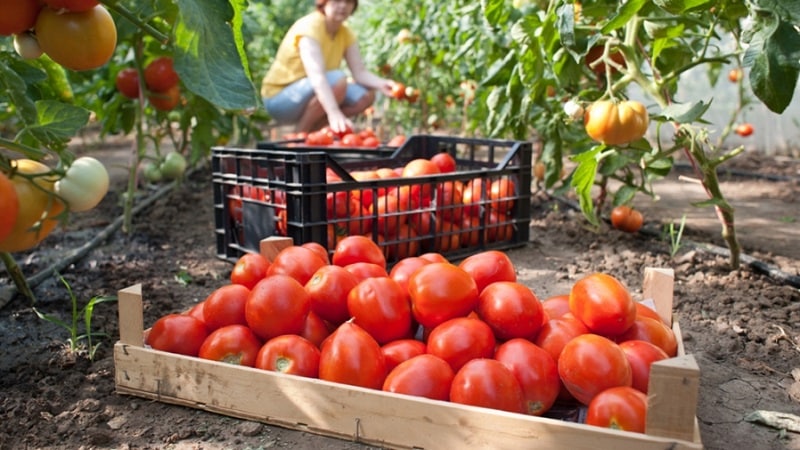
Pros and cons of the variety
Tomato growers emphasize the advantages of the variety:
- tomatoes do not crack on the bush;
- fruits are well stored and transported;
- Tomatoes have sugary pulp, reminiscent of watermelon.
The disadvantages include the fact that plants need increased attention and additional care (formation of a bush, garter).
How much do the seeds cost?
Manufacturers promise customers premium seeds. When purchased online with postal delivery, a pack of seeds costs 95-100 rubles. The package contains 6 tomato seeds. Sellers in catalogs note that Red Red tomato seeds are a hit in their sales.
How to grow
The variety is generally standard in terms of cultivation technology.
Sowing seeds
Seeds for seedlings are planted in early March (allowed at the end of February). Before planting, it is advisable to soak the seeds in a solution of a growth stimulant, for example, Epin. The solution is prepared following the dosage of the drug from the manufacturer's instructions. The depth of planting seeds in the ground is 1-1.5 cm. It is recommended to moisten the earthen ball well.
Attention! It is better to buy the soil in which the seeds will be planted at a specialized store. If you take soil from your garden beds, there is a risk of infecting seedlings with diseases and pests from undisinfected soil.
The container with the planted seeds is covered with plastic film to create a microclimate favorable for seedlings and placed in a dark, warm place. When sprouts appear from the soil (after 5-8 days), the film is removed. The container is brought out into the light. When the soil dries out, water it moderately with settled water at room temperature.
Seedling care
When two true leaves appear on the sprouts in addition to the cotyledon leaves, the seedlings need to be plucked - each plant should be planted in a separate container. This will allow the seedlings to grow stronger and develop a full-fledged root system.
Attention! Water the seedlings moderately; excess moisture will not do any good.
At the beginning of May, the seedlings begin to be hardened - exposed to conditions close to street conditions. So, first the plants are left for 10-15 minutes. with the window open, then the active ventilation time is gradually increased to 1 hour.
After a week, the seedlings are taken out to the loggia or balcony and left for several hours. Be sure to leave it in a warm room overnight.
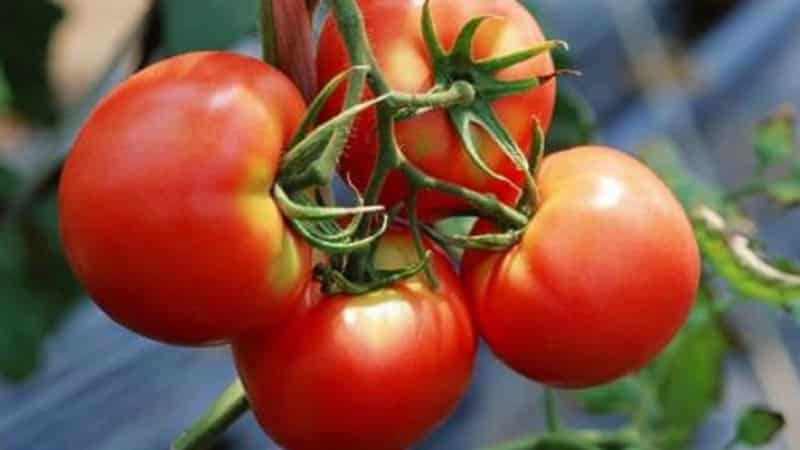
Disembarkation at the main place
If the tomatoes grow in a greenhouse, they are transplanted to the main place in early May. If in open ground - in early June, when the threat of night frosts has passed.
Seed producers recommend forming a tomato bush into one stem, so the distance between plants in a row (both in the greenhouse and outside) can be kept small: 30-35 cm will be enough.
The gap between the rows is 50 cm. If you plan to grow a tomato bush with two stems, the plant will be more spreading, so the distance in both directions should be increased by 10-20 cm.
Bush formation
During the growth process, the Red Red tomato needs the formation of a bush. The best results can be achieved if the plant is grown in one stem. To do this, you need to constantly remove all side shoots.
Some tomato growers form a tomato into two stems - leaving one stepson below the first flower cluster. A good harvest is also harvested from the two fruiting stems.
Garter
Red tomatoes are tall and cannot support their own weight. This means that the plants need to be tied to supports.When grown in a greenhouse, they are usually tied to the upper ceiling supports. In open ground - to pegs or trellises.
For tying, strips of fabric, braid, and twine are used. Unnecessary nylon tights cut into strips are also suitable. They do not cut into the stem and do not injure the tomatoes.
It is important that the plant is not pulled into a string along with the garter material. Otherwise, when caring (watering, fertilizing, pinching), there is a risk of snagging the bush and tearing the plant out by the roots.
Watering
Plants are watered 1-3 times a week depending on weather conditions. It is advisable not to use cold water - such watering slows down growth and development.
After planting in the ground in the main place, it is better to refrain from heavy watering. The less moisture a tomato receives from the soil surface in the first stages of adaptation, the better its root system will develop (the roots will strive to receive moisture from the deeper layers of the earth).
During the period of fruit ripening, watering is increased. The Red variety is not prone to cracking, so there is no need to worry that the quality of the fruit will deteriorate.
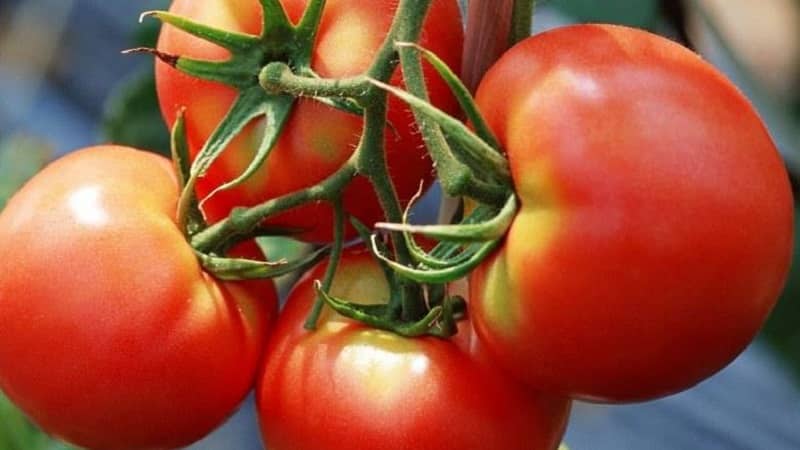
Top dressing
To get a large harvest, it is recommended to feed tomatoes. It is advisable to make 3 feedings. They are carried out in phases:
- budding;
- flowering;
- fruit ripening.
Experienced tomato growers prefer to feed tomatoes in two ways:
- at the root (nutrients are added to the ground at the base of the plant);
- on the leaves (fertilizer in the form of a solution is sprayed onto the above-ground part of the tomato bush).
The procedures alternate with each other.
A favorite fertilizer for gardeners, which increases yields by 15-20%, is fertilization with an aqueous solution with the addition of boric acid, iodine and ash.
The solution is not sold in gardening stores - it is not suitable for storage and loses its beneficial properties over time. The tomato growers prepare it themselves. To prepare the fertilizer, take 10 g of boric acid crystals, 10 liters of water, a bottle of alcohol tincture iodine (you will need 10-12 drops) and 1 liter of wood ash.
Note. Iodine and boric acid can be bought at the pharmacy, ash can be raked out of the stove or collected at the fireplace.
Boric acid crystals are poured into 1 liter of hot (from 60 degrees) water and stirred until completely dissolved. Then the hot solution is mixed with ash and iodine. Pour into 9 liters of water. The average feeding consumption is 0.5 liters per tomato bush. It is advisable to fertilize after the soil has been watered with plain water.
Harvesting
The fruits are harvested regularly as they ripen. This promotes rapid ripening of the remaining tomatoes on the bush. You can also pick green fruits - they ripen easily.
If you regularly remove tomatoes from the bush, this gives an impetus to the appearance of new ovaries. The harvest period lasts until September.
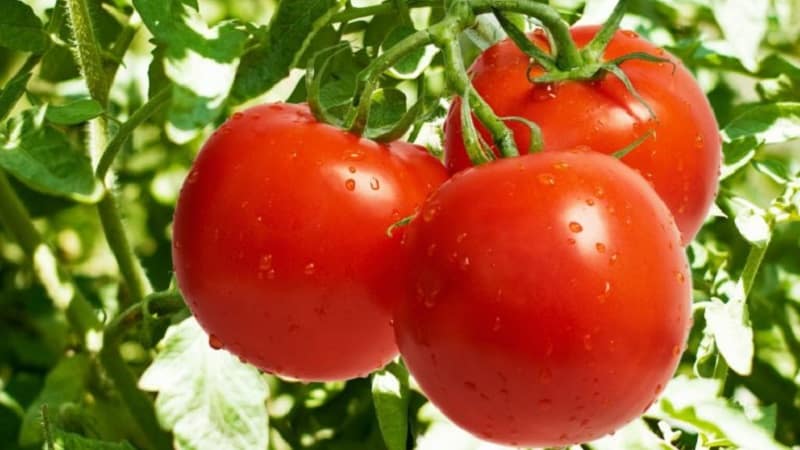
Prevention of diseases and pests
Compliance with crop rotation rules and folk remedies will help prevent pests and diseases.
Pre-sowing tillage helps prevent diseases. For example, watering the soil with a solution of copper sulfate (according to the manufacturer's instructions) before planting plants. TO late blight The variety is resistant to blossom end rot and is rarely affected by them.
Of all the pests, the variety is most susceptible to attacks by aphids. Garlic sprays repel her. The solution is prepared from 200 g of garlic, infused in 4-5 liters of water for 3 hours. Spraying is carried out in dry, cloudy weather.
Many pests do not like calendula, so it is recommended to plant these flowers along the edge of the tomato row.
Reviews from gardeners
Among the reviews about the variety, positive ones predominate. Many gardeners pay attention to the taste of fruits. Reviews from those who have already planted red tomatoes:
Valery Yu., 54 years old, Smolensk: “I planted these tomatoes as an experiment. I liked it. Massive bunches of tomatoes have grown, there are a lot of fruits on the bunch, all calibrated.”
Zinaida Vitalievna, 62 years old, Moscow region: "On the packaging with seeds it was a very beautiful photo. I decided to plant it and then pickle it whole. They turned out to be too big, not a lot of them fit into the jar, there are empty spaces between the tomatoes. Marinated in halves. I liked the fresh ones: meaty and sweet.”
Katerina Anisko, 30 years old, Novotroitsk: “They look beautiful, round, but taste like ordinary tomatoes. They have a thick skin and store well.”
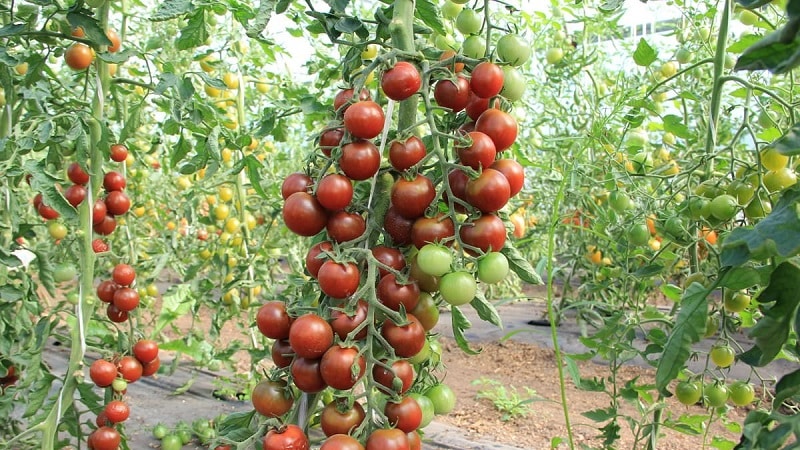
Let's sum it up
The variety requires increased attention in the form of gartering and bush formation. In general, caring for tomatoes is standard. They are grown both in greenhouses and in open ground.
If you use fertilizing, you can increase the yield by 15-20% and get up to 8 kg of tomatoes per bush. Those who have already tried to grow Red Red tomatoes speak positively about the results.